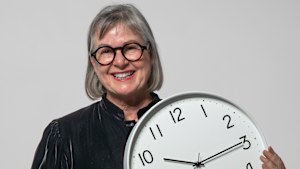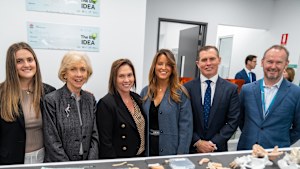While its staff remuneration system, full of golden handcuffs and parachutes, is the envy of the banking industry, the AIDC's operating profit is less than enviable. And low morale has prompted another wave of executive defections. ROWENA STRETTON reports on how an institution lost its way. THE Australian Industry Development Corporation was the child of the resources boom and economic patriotism of the 1970s and was known as the "McEwen's Bank" because of its support from Country Party leader "Black" Jack McEwen. Liberal Prime Minister John Gorton established AIDC in 1970 to develop Australian resource-based industries - 15 years before the deregulation of financial markets for there was a development capital void to fill. Then in Opposition, Labor's Gough Whitlam said the corporation could be an instrument for the pursuit of the "democratic socialist purpose". Later, with Labor in power, Trade Minister Jim Cairns saw it as a way of using foreign capital to secure Australian sovereignity over its fuel and energy. By 1975 the conservative think-tank, the Institute of Public Affairs, had dubbed the corporation a "Heath Robinson monstrosity". But over the next 15 years it flourished, lending to and taking equity in hundreds of mining and manufacturing, technology and tourism projects - from Dick Pratt's Melbourne-based box making business to Alcan's third smelter potline at Kurri Kurri in NSW to Queensland's Kewarra Resort at Palm Cove. Wesfarmers chief executive Michael Chaney cut his teeth there as did the head of investment at the State Superannuation Board of NSW, Elizabeth Bryan. And its board over the years included a mixture of knights (including Sir Alan Westerman), financial whizzes (like Bill Ferris), entrepreneurs (like Denis Horgan) and future chief executives (like John Ralph). The 1980s brought competition and partial privatisation. When the asset inflation bubble burst AIDC Ltd was left, like the major banks, with a number of problem loans but no buffer of mortgage income. Enter Citibank Australia's deputy chief, Gerry Van der Merwe. He walked into the outfit's Kent Street tower in January 1992. Three and a half years later, and having received $1.8 million renumeration in the latest year, Van der Merwe walked out. He left an organisation with the some of the highest-paid senior managers in Australian corporate history, but with corresponding low morale and and nose-diving operating profits. After a reported 43 per cent leap to $65.7 million in 1992, operating profit before credit charges then retreated in 1993 to $57 million, then $35 million in 1994 before slumping last year to $18.7 million. Ironically the former federal government was just mopping up its takeover of AIDC Ltd's minorities when the Liberals were elected to power. Now the Liberals, committed to selling off the organisation, has won power, the atmosphere on the 34th floor at the AIDC Tower in Sydney is reportedly tense. Said one insider at AIDC's bunker, a day before last weekend's federal election: "Right now, working here is the easiest thing in the world. There is no pressure. The first excuse was that we didn't know what the government was going to do. Then the government took us over. The new excuse is that if the Libs get in, it will take them three months to settle down. I can't stand working in this sort of environment." As well as the lack of a buzz, he points to the nagging effect of the massive pay inequities implemented two years ago: "In general we are paid pretty well. The trouble is that when the guy sitting next to you gets close to a million dollars a year you don't feel so good. The system brought in during the Van der Merwe era destroyed the soul of the organisation. And they haven't done anything to fix it." Although uncertainty of ownership has been the excuse for a lack of performance, word is that life has been apparently been so comfortable that one divisional chief confided to a friend recently that the place had never been so depressing. Indeed, management brought in or promoted during the Van der Merwe era still dominate. Chris Skilton, the AIDC's chief financial officer who replaced Van der Merwe in the top job last May, admits to a morale problem: "I inherited a company last May with extremely low morale. You can give people a sense of direction, but to fix morale you've got to be busy and successful. We are busier and more successful, but we've got a way to go ... morale is gradually building, though from a low base." Skilton denies that his own admission to the Golden Ten Club (he took home about $900,000 last year) has undermined his leadership: "The payments were somewhat extraordinary things put in place at an extraordinary time. I was a recipient of them, not their architect. I think most people now see them as in the past and are looking to the future." Late last year Skilton sought and received Tell It As It Is input from the second tier of management. He was told of difficulties dealing with clients who "throw the flak about the golden handcuffs in our face", how the outfit's infrastructure push had been poorly implemented, how there was a perceived sense of a lack of commitment at the very top and how there was lingering indignation about the inequitable pay. Skilton's response was a now-legendary October memo defending the payments and suggesting that anyone with a morale problem leave: "I am determined that a small vocal minority are not going to contaminate the whole organisation," his memo is understood to have said. And they are leaving. Since Christmas AIDC's financial markets chief Phil Coffey has left to head Westpac's international and institutional banking - only the second Golden Ten member after Van der Merwe himself to have snapped open the golden cuffs. The other defectors - Richard Williams (AIDC Treasury, Sydney), Seth Moldoff (Investment, Sydney) and Brian Meltzer (Investment, Melbourne) are considered strong performers who will take their place with others who have flourished "outside". People like former AIDC executives Darce Corsie, now project finance director at the Deutsche Bank-owned Bain and Company, Drone Chowdry, now vice president, Syndications, at the Commonwealth Bank and Paul Morris, senior manager, syndications, at Westpac. Close sources agree that the big bikkies received by the top management team from 1994 - heralded as a means of retaining their services in the uncertain environment of a potential federal government selldown - split the organisation into haves and have-nots. Most employees received a payment equivalent to between 10 and 30 per cent of salary, paid in two tranches, with the second tranche still due. The Golden Ten management elite received a payment representing multiples of their salaries, delivering 10 of them in 1994-95 more than $700,000 each, understood to not include benefits like superannuation and cars. They have received three loyalty payments with the final payment due in 1996-97. One former employee described the generosity of the payments as "a joke", saying that far lower payments would have bought as much loyalty. He said that the executives who were not included did not so much blame the managers for accepting the payments ("it's human nature") but blame whoever ultimately approved it. Skilton refuses to break down last year's published renumeration into salary, bonus and loyalty payment, but has publicly talked up the bonus element, predicting that the top people will earn up to half of last year's amount this year. Despite the top dollars thrown at the top, the AIDC is generally considered within its sector to be weak in all its markets. And again renumeration is involving management attention. UK-based consultants are at the outfit looking at senior management renumeration to replace share options in the wake of the AIDC's delisting. Skilton says it is a standard review "to ensure that we are competitive with the market". Meanwhile, the business itself has a less than startlingly competitive reputation. Said one former executive, who quit on principle just before a loyalty payment was due, summed it up: "I think that we who left are still trying to write it out of our CVs. It is a real pity." Rivals say the outfit "lost its way" early this decade, that it "lacks a hard edge" and seems unable to identify the real rainmakers, let alone promote them to its A-Team. The only thing that rivals envy about the outfit is its AAA rating, courtesy of the government guarantee that the former government promised to renew in 1998 if the Australian Industry Development Corporation takeover of AIDC minorities was successful. Which it was. Ironically, the renewal is part of the game plan for the outfit to become "guarantee independent" by 2000. On alleged management weakness, one former executive who recently quit said: "Why should they worry? These guys get huge salaries and bonuses and retention payments that still have one leg to go. And on top of that they have golden parachutes so they get paid handsomely if the place is wound down or sold off." It is now four years since his predecessor Van der Merwe paid the LEK Partnership to help come up with the AIDC's strategic push into infrastructure and resources and define its need to maximise interest and fee income. Skilton says the AIDC's objectives are "to increase business in four major areas - net interest, fees, dividends and capital gains ... and put more emphasis on credit-related and fee income." So how were they going? "The (upward) trend is there." But Ernst & Young, in its October Independent Expert Report on the takeover, estimated maintainable earnings of a mere $7 to $8 million. It said the competitive advantage of AIDC's Investment and Advisory Services had been "diminished recently" while Financial Services had "suffered a low level of new loans written recently". Skilton points to the organisation's role as equity holder and adviser in the Sydney Light Rail Company Limited, its $20 million City Link investment in Victoria and its advisory role in Victoria's new chemical storage facility at Point Lillias as projects "giving us a track record in the areas we have targeted". Meanwhile, for three years operating profit has been poor. For three years writebacks had boosted the bottom line. Says Skilton: "Certainly they did and do add to the bottom line. They are clearly disclosed as a line item in the accounts. But we are reaching the rump of the workout book." He said this year's writebacks would be "modest". Former employees talk in unison about how the writebacks became so important. Van der Merwe had walked into the AIDC in 1991, at the height of the recession. After consultation with consultants he decided to write off and run down much of the industrial company loan and equity book and redirect the company strategy to financing and fee-based advice for infrastructure and resources projects. A typical case was the AIDC's $7.2 million sale of its 10.3 per cent stake in Siddons Ramset in October 1992 at the bottom of the economic trough. Once the book had been run down, there was no room to take risks. Applications were rejected wholesale. New business dried up. Management at the time said the 1992 $165 million writedown was biting the bullet in a tough economic environment. Over the next three years a net $50 million was written back to profit, boosting the bottom line despite the progressive deterioration of operating profit before credits or charges on loans and investments. It was believed that several executives received bonus rewards after the first write backs, precursors of the golden handcuffs that followed. One former employee commented that all the banks were doing that, but not necessarily to that extent. Operating profit went from $65.7 million in 1992 to $18.8 million in 1995. And that income is the measure of the volume and profitability of a business." Executives critical of this were also upset by a round of hiring and firing. Said one former executive: "Gerry retrenched some of the best business brains, which he privately admits now, and brought in a heap of American-style merchant bankers at senior levels." Said another former executive: "They spread too many things too thinly. They were trying to be all things to all people. They wanted to be in securitisation, equity markets, capital markets, corporate finance. You name it ... the focus was not sharp enough." One bleak spot - despite a promotional brochure featuring key executives in full page photographs - was the attempt to beef up corporate finance, led by Van der Merwe appointee, Peter Corben who had been chief of the bank of New York's Australian operation. Insiders say an alphabetically based pitch to corporates failed to bring results. Corben left and the division was folded a year later. The day before the election Skilton sounded relaxed. He said he had no reason to doubt that a Liberal Government would not honour the commitment made by former Labor ministers Kim Beazley and Senator Peter Cook to existing management. The first working day post-election, Skilton's spokesperson, Amy Mihalakis, said the election of a party with a sell-the-AIDC policy had not changed the mood: "The previous government was going to sell us anyway." WHERE ARE THEY NOW? ALL but two of the AIDC's Golden Ten are still there, including current boss, Chris Skilton. Although there were 11, the group is known as The Ten because one person among the eleven, Kim Cottle, was comparatively junior. Her salary did not reach magical heights.
Van der Merwe left in May. Financial markets chief Phil Coffey quit last month.



